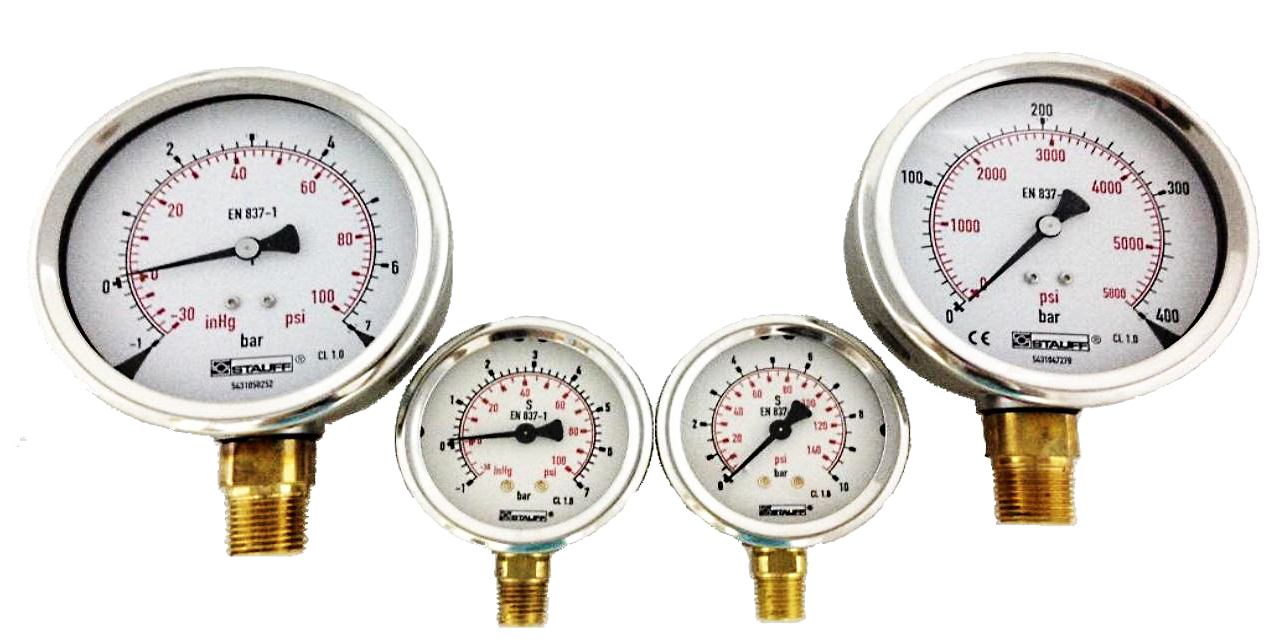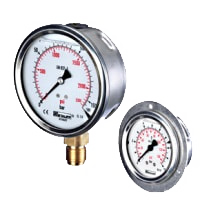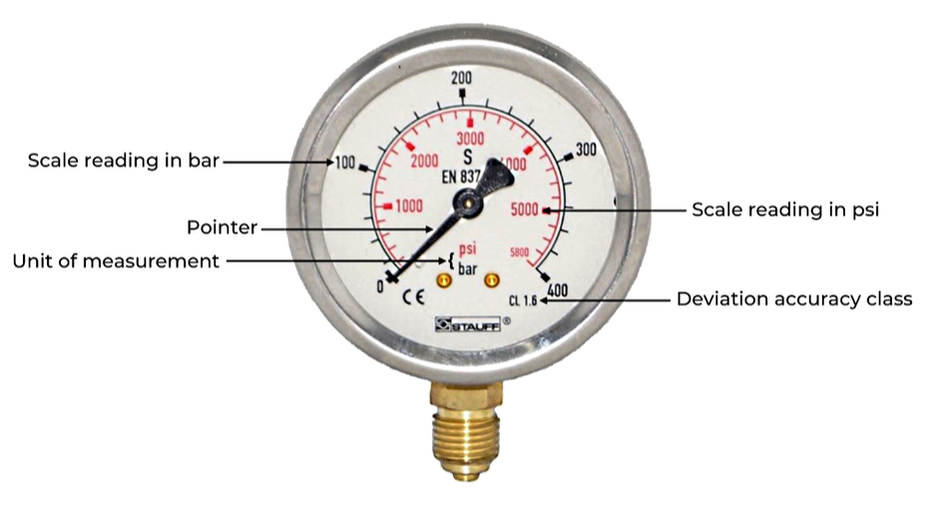What are pressure gauge1. What is a pressure gauge used for?
| Measuring pressure is necessary for monitoring and ensuring the smooth functioning and operating safety of systems. It can be used as a portable or stationary device for user to determine the pressure rating of a hydraulic system. Pressure gauges come in different type of connection ports to suit different installation needs and are offered in a variety of different range of pressure readings. |  Dry Dial Gauge Dry Dial Gauge |
2. What is the working principle of pressure gauge?
The most commonly used bourdon tube pressure gauges are functioning using the mean of mechanical movement principle and the pressure is transmitting via the bourdon tube, a C-type curved tube with a non-circular cross-section inside the pressure gauge.
When the medium flows and enters the gauge, the internal space of the bourdon tube is pressurized, and it tends to expand the bourdon tube. As a result, the mechanical movement is converted in which the expansion of the bourdon tube will trigger to rotate the pinion and thus generate a rotary movement of the pointer which will show the operating pressure reading on the dial itself.3. What are the different types of pressure gauges?
| The available size range for the dial face (circular diameter of dial face) is 63MM (2 1/2”) and 100MM (4”). There are two different types of connection port, stem (bottom) mounting and panel (back) mounting. For the thread connection, it is available in BSPP (G1/4” and G1/2”) and NPT (1/4”NPT and 1/2”NPT) to connect with systems running with nominal size standard as their main dimension measurement. The nominal size of 1/4” is usually used for gauges with dial face of 63MM, while 1/2” is usually for dial face of 100MM. Analogue pressure gauges also have standard dual scales pressure indication in bar and PSI (pounds per square inch). |  Stem Mounting & Panel Mounting Pressure Gauge Stem Mounting & Panel Mounting Pressure Gauge |
Alternatively, digital pressure gauges are designed to measure the working pressure specifically for hydraulic oils, lubricants and water. The current measured values can be shown, as well as displaying the minimum and maximum values, with a accuracy of 0.5% of the full scale. Both analogue and digital pressure gauges are available in pressure test kit and can be supplied with gauges that come with different pressure readings and adaptors to suit various requirements upon request.
The most common type of pressure gauge is analogue pressure gauge. They are inexpensive and easy to use with its mechanical movement principle. Moreover, they do not require a power source to operate. The way to obtain the pressure reading is also simple by reading at the needle that directly responds to the pressure rating detected by the measuring element. It can be easily noticed and monitored.
| Dial Size in mm | 63mm | 100mm |
| Dial Size in inch | 2 1/2″ | 4″ |
| Connection | BackBottom | BackBottom |
| Size connection | 1/4″ | 1/2″ |
| Thread connection | BSPPNPT | BSPPNPT |
4. Why are pressure gauges filled with liquid?
When pressure gauges are installed in a system, there is a high possibility that the vibration created will lead to poor performance and failure in pressure gauge. These problems can be minimized by filling up the pressure gauge with liquid. The most commonly filled liquid in pressure gauge is glycerine oil.
The application of pressure gauge that filled with glycerine at room temperature can provide a good vibration dampening. These glycerine-filled gauges can perform well in temperatures between -4°F and +140°F (-20°C and +60°C). When analogue pressure gauges are filled with glycerine oil, it can help to maintain the accuracy of the pointer reading by reducing the effects of vigorous vibration and oscillation of the reading needle.
The filled oil can also work as a movement lubricant and protect the internal parts of the pressure gauge. In general, it improves reliability and extends the lifecycle of the pressure gauge. The longer lifespan of the pressure gauge will result in longer-term in cost savings for the entire system as well.
5. How to read a pressure gauge?
The way to read a pressure gauge is through looking at the dial of the pressure gauge which contains plenty of information. To obtain the pressure value, we need to see the pointer which will point to a figure that indicates the current pressure rating of the system.
 Dual Scale Analogue Pressure Gauge Dual Scale Analogue Pressure Gauge | Next, the unit in which the pressure gauge measure also needs to be identified. The unit can be in dual scale which will be showing in bar and psi, the scales are differentiated by using two colors. For example, the pressure measured in bar is represented by the outer scale reading and is in black, meanwhile to read the pressure in psi, it is represented by the inner scale reading which showing as red. |
The deviation accuracy class is also shown in the dial as CL. It is to indicate the deviation of the display value in percentage from the full-scale value. The most common accuracy classes for pressure gauges are 0.6%, 1.0%, 1.6% and 2.5%. On pressure gauges, we can also find a black triangle, this is helping to mark the maximum pressure at a steady loading.
6. How do you know if a pressure gauge is accurate?
Pressure gauge can be calibrated to make sure the readings on the gauge are accurate. The test will be done by a laboratory and a calibration certificate will be issued to prove the gauge’s accuracy. A calibration test can help to determine and maintain the accuracy of the pressure measurement and hence maintain its quality and to ensure the pressure gauge can function properly. Click Here For Enquiry Www.atharvahydraulic.com
hello there